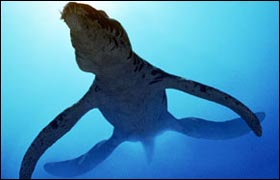A complete (but fossilized) skeleton of a giant sea creature - possibly the largest marine reptile that ever lived underground - was discovered in northeastern Mexico

A complete (but fossilized) skeleton of a giant sea creature - possibly the largest marine reptile that ever lived underground - was discovered in northeastern Mexico. The researchers identified it as the largest predator that "ruled" the depths of the ocean about 150 million years ago.
The zoological name given to it is "Leopleurodon Prox" - a type of dinosaur ("plesiosaur"). He was a meat eater and his "meals" were based on small reptiles, capable of swimming. It is estimated that the body length of this monstrous creature - from the nose to the tip of the tail - reached 25 meters and weighed over 150 tons.
At this point, the researchers gave it the name "The Monster from Arambury", after the site where it was discovered. This is the first time that a perfect fossil of such a creature has been discovered (previously only parts of the skeleton were discovered).
The experts of the Museum of Natural History in Karlsruhe, Germany, will now deal with the reconstruction of the bones, with the aim of trying and building on the basis of the skeleton, a complete figure of this animal, for display.
As far as is known, the creatures called "plesiosaurs" appeared in the world in the early Jurassic period, and quite quickly this group split into two: the long-necked ones, like the cryptocleidoids, and the short-necked ones, the "plesiosaurs".
Marine reptiles are cousins of the dinosaurs that inhabited the earth between 208 million and 65 million years before our time.
Alex Doron

3 תגובות
In the sixth line you write that it is a dinosaur and then at the end you write that it speaks of marine reptiles that are relatives of the dinosaurs.
The last comment is accurate. There were no flying dinosaurs and there were no swimming dinosaurs back in the day. These are marine reptiles or flying reptiles. Specific to the creature that was discovered, it was probably the largest marine predator ever, which ate everything that was weaker than it, including its own kind.
Only the megalodon in a later period equaled it (some think that the megalodon had a stronger bite force, but it was probably smaller in size).
I must point out that the estimates regarding its weight seem far-fetched. 150 tons by 25 meters? in the sea? There is no precedent for this. On the face of it, you have a mistake.
Pretty
Is it so complicated to show a picture of the skeleton or at least give a link?